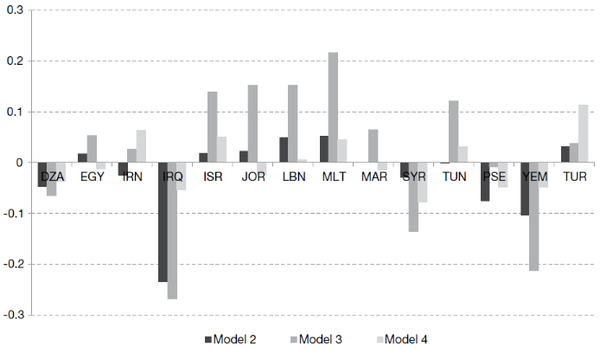Economie et Statistique / Economics and Statistics n° 503-504 - 2018 Migrant Remittances and Economic Growth: The Role of Financial Development and Institutional Quality
THE ARTICLE ON ONE PAGE
Key question
In the last two decades, remittances reached the highest level in history and the receiving countries realized their importance. Despite a growing literature, there is no clear consensus on their impact on economic growth. Do migrants’ remittances have a direct, positive, impact on economic growth, or rather in interaction with contextual factors? To what extent do the development of the financial sector and the quality of institutions condition the impact of remittances on growth?
Methodology
The analysis covers an unbalanced panel of 14 Middle East and North Africa (MENA) countries over the period 1982-2016. Estimations are based on an extended version of Barro’s growth model (1991; 1996), where interaction variables have been included to assess the conditions in which remittances can improve economic growth. A panel Fixed Effects Two-Stage Least Squares (FE 2SLS) estimation is used to deal with potential endogeneity and measurement errors.
Main results
In MENA countries, the estimations show that:
- Remittances do not have a direct impact on economic growth;
- Remittances and the degree of financial development have a complementary effect that boosts GDP growth, but a minimum level of financial development is required for remittances to have a positive effect. With financial development measured by the ratio of domestic credit provided by banks to GDP, this threshold is estimated at 4.2. Only 8 out of the 14 countries in the sample reach this level;
- Remittances and institutional quality are complements in enhancing growth. Specifically, higher levels of institutional quality could eliminate the potential negative effects of remittances on economic growth.
graphiqueMarginal Effect of Remittances on Economic Growth by Level of Financial Development

Message
This analysis suggests that certain conditions must be met for migrants’ remittances to become more than just additional income and turn into productive investments. The level of financial development and quality of the institutional environment have been found to be such conditions. However, this result is limited by the lack of a composite measure taking into account simultaneously the size, depth and efficiency of financial institutions on the one hand and the unequal availability of data on institutional quality across countries, which makes international comparisons difficult on the other.
Article on one page (pdf, 49 Ko )



